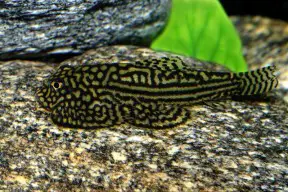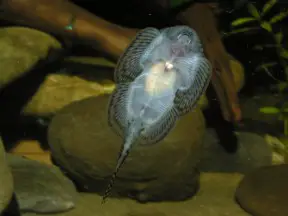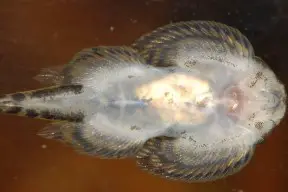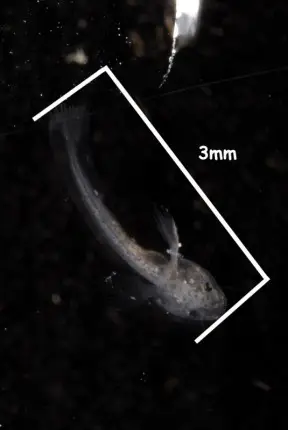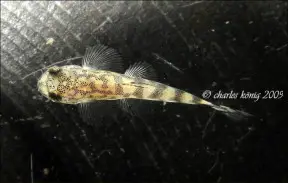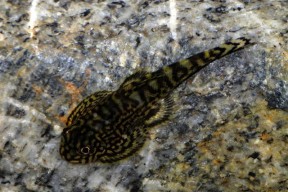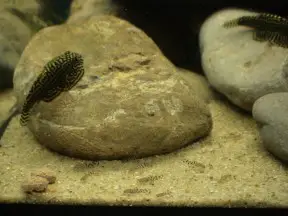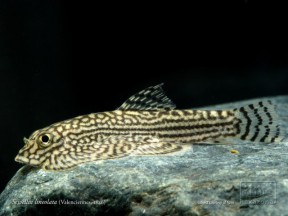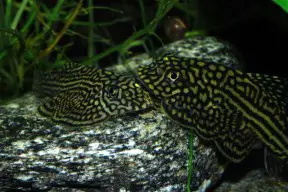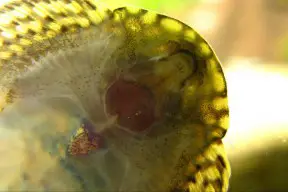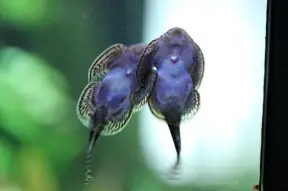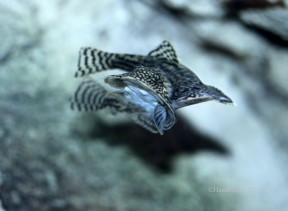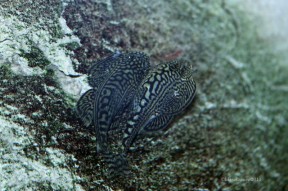Sewellia lineolata
Tiger Hillstream Loach
SynonymsTop ↑
Balitora lineolata Valenciennes, 1846; Sewellia songboensis Nguyen & Nguyen, 2005
Etymology
lineolata: from the Latin linea, meaning ‘line’, and -ola, the latter a suffix used to indicate small size.
Classification
Order: Cypriniformes Family: Gastromyzontidae
Distribution
Native to Vietnam where it’s known from the provinces of Thua Thien-Hue (Huong river drainage), Quang Nam (Thu Bon river), Quang Ngai (Tra Khuc and Ve rivers) and Binh Dinh (An Lao river).
Type locality is given as ‘Cochinchine’, which presumably refers to the region of Cochinchina encompassing the country’s southern portion.
Rainboth (1996) reported it to occur in the Khone Falls on the Mekong River in Laos, close to the border with Cambodia, and it can apparently be found in some hill streams of that area.
Colour and patterning may vary somewhat depending on collection locality though all possess the same basic characters.
Habitat
Restricted to shallow, fast-flowing, highly-oxygenated headwaters and tributaries characterised by stretches of riffles and runs broken up by pools or cascades in some cases.
Substrates are normally composed of bedrock, sand and gravel with jumbles of boulders, and while riparian vegetation is often well-developed aquatic plants are typically absent.
The most favourable habitats contain clear, oxygen-saturated water which, allied with the sun, facilitates the development of a rich biofilm carpeting submerged surfaces.
During periods of high rainfall some streams may be temporarily turbid due to suspended material dislodged by increased (sometimes torrential) flow rate and water depth.
At one locality in the upper Thu Bon this species was collected from a very fast-moving (> 1 m per second) stretch of river around 80 m wide and containing turbid water.
There was a series of rock-filled rapids and deep pools with a sandy substrate, and the fish were also collected in marginal rocky pools unconnected to the main river.
Maximum Standard Length
55 – 65 mm.
Aquarium SizeTop ↑
Minimum base dimensions of 75 ∗ 30 cm are recommended for general care. Smaller tanks can be used for breeding.
Maintenance
The water must be clean, well-oxygenated, and ideally turn over 15-20 times per hour so we suggest the use of an over-sized filter as a minimum requirement plus additional powerheads, airstones, etc., as necessary.
Aged driftwood can also be used but avoid new pieces since these usually leach tannins that discolour the water and reduce the effectiveness of artificial lighting, an unwanted side-effect since the latter should be strong to promote the growth of algae and associated microorganisms.
Exposed filter sponges will also be grazed, and some enthusiasts maintain an open filter in the tank specifically to provide an additional food source.
Although rarely a feature of the natural habitat aquatic plants can be used with adaptable genera such as Microsorum, Crinum and Anubias spp. likely to fare best.
The latter are particularly useful as their leaves tend to attract algal growth and provide additional cover.
Since it needs stable water conditions and feeds on biofilm this species should never be added to a biologically immature set-up, and a tightly-fitting cover is necessary since it can literally climb glass.
While regular partial water changes are essential aufwuchs can be allowed to grow on all surfaces except perhaps the viewing pane.
Water Conditions
Temperature: Can tolerate higher temperatures provided its oxygen requirements are maintained but for general aquarium care a value of 20 – 24 °C is recommended.
pH: 6.0 – 7.5
Hardness: 18 – 179 ppm
Diet
Much of the natural diet is composed of benthic algae plus associated micro-organisms although insect larvae are probably taken on an opportunistic basis.
Home-made foods using a mixture of natural ingredients bound with gelatin are very useful since they can be tailored to contain a high proportion of fresh vegetables, Spirulina and similar ingredients.
For long-term success it’s best to provide a mature aquarium with a plentiful supply of algae-covered rocks and other surfaces.
If unable to grow sufficient algae in the main tank or you have a community containing numerous herbivorous fishes which consume what’s available quickly it may be necessary to maintain a separate tank in which to grow algae on rocks and switch them with those in the main tank on a cyclical basis.
Such a ‘nursery‘ doesn’t have to be very large, requires only strong lighting and in warmer climates can be kept outdoors.
Algal type is also important with diatoms and softer, green varieties preferred to tougher types such as rhodophytic ‘black brush’ algae.
Gastromyzontids are often seen on sale in an emaciated state which can be difficult to correct.
A good dealer will have done something about this prior to sale but if you decide to take a chance with severely weakened specimens they’ll initially require a constant source of suitable foods in the absence of competitors if they’re to recover.
Behaviour and CompatibilityTop ↑
In terms of behaviour Sewellia spp. are perhaps the most dominant of the ‘sucker belly’ group of loaches though they’re not generally aggressive towards dissimilar-looking fishes.
Potential tankmates include small, pelagic cyprinids such as Tanichthys, Danio, Devario, and Rasbora, stream-dwelling gobies from the genera Rhinogobius, Sicyopterus, and Stiphodon, plus rheophilic catfishes like Glyptothorax, Akysis and Hara spp.
Some loaches from the families Nemacheilidae, Balitoridae and Gastromyzontidae are also suitable but others are not so be sure to research your choices thoroughly before purchase.
Similarly-shaped, less bold gastromyzontids such as Gastromyzon or Hypergastromyzon spp. tend not to compete well for food and territory, however, and if the latter resources are limited even members of relatively robust genera such as Pseudogastromyzon may struggle to impose themselves.
Other benthic species may also be outcompeted, especially those inhabiting similar parts of the tank like Annamia, Formosania, Homaloptera, Liniparhomaloptera and Vanmanenia.
Such combinations are best attempted only in larger, well-structured aquaria where space is not an issue.
In the wild Sewellia spp. tend to occur in quite large aggregations so buy a group of 6 or more if you want to see their most interesting, natural behaviour.
They’re territorial to an extent with some individuals more protective of their space than others (often a prime feeding spot). This appears related to gender with males normally dominant.
Dominance battles are entertaining to watch and often take place in a belly-to-belly stance with both fish raising their bodies from the substrate in a near-upright position.
The purchase of several fish will also reduce the likelihood of a particular subdominant individual(s) being singled out, and make the group less nervous of activity outside the tank.
Sexual Dimorphism
The most obvious external characteristics are the shape of the head and body when viewed from above, with females having a comparatively broad body and a snout running almost continuous with the pectoral fins.
Males are slighter and the snout is much squarer in shape with the pectoral fins emerging from the body almost at right-angles.
Sexually mature males also develop rows of soft, raised tubercules on the anterior portion of the first 5-6 pectoral-fin rays which have been referred to as ‘fences’ in the hobby, plus additional rows on the dorsal surface of the head.
Reproduction
Sewellia spp. are arguably the easiest of all loach species to breed in aquaria and success has been achieved with several species.
Initial reports mostly described recovering fry that had been sucked into external canister filters in hill stream-style arrangements such as that described above (see ‘Maintenance’), or discovery of small numbers surviving in mature community set-ups.
However subsequent experiments have shown that they can be bred in numbers in very simple quarters using groups of adult fish.
Perhaps the most important aspect in a controlled breeding attempt is provision of a suitable, mature substrate.
A large grade of rounded river gravel is best as the many nooks and crannies created allow eggs to develop within without being eaten by the adults and provides refuge for the fry until large enough to escape predation.
The organic detritus that tends to collect in this type of substrate also provides a food source for micro-organisms which in turn are eaten by fry.
Other décor can consist of some smooth, algae-covered rocks for the adults plus an air-powered, sponge-type filter to provide oxygenation and an additional grazing surface.
This type of filter has an added advantage in that eggs and fry won’t be drawn into it.
Spawning can apparently be triggered by raising the temperature to 77-78.8°F/25-26° for a period before conducting a cool water change although in many cases simply performing the latter has proven enough.
Courtship is initiated by the male and involves fluttering displays and chasing of the female.
When a female appears receptive the behaviour of the male changes to include circling of his potential partner, mouthing of the dorsal surface and pushing of his head into her body, seemingly in an attempt to dislodge her into open water.
The act itself involves the pair rising into the water column with pectoral fins entwined before eggs and milt are released directly into the water flow, usually where the current is strongest.
Presumably this is an effective means of downstream dispersal in nature, allowing the fry to develop in quieter waters before migrating upstream to join the adults once approaching maturity.
In one experiment an adult pair of S. lineolata was provided with an open bowl filled with gravel and woollen mops within which the fish spawned suggesting that in nature spawning may be an opportunistic affair dependent on environmental conditions to an extent.
The incubation period for Sewellia eggs appears to be undocumented but once fry are spotted it’s important to provide suitably-sized food items.
Infusoria is a good initial diet followed by Artemia nauplii, microworm, etc. once they’re visibly foraging above the substrate.
The body shape of the fry is less laterally-compressed than in adults and they initially possess small barbels which reduce progressively as they mature.
The pectoral and pelvic fins are also relatively short to begin with meaning the young are unable to cling to surfaces in the same way as adults, instead spending all their time on or within the substrate.
The adults seem not to predate on the fry once they’re around 5 mm or so in length and they can be left together should you wish. In community aquaria filtered by external units care should be taken when performing filter maintenance as fry can often be found inside.
NotesTop ↑
S. lineolata was first recorded by Diard over 150 years prior to its ‘rediscovery’ in the early-1990s.
It became available to the aquarium trade in the mid-2000s and swiftly established itself as one of the more popular balitorids in the hobby due to its attractive body markings and ease of breeding.
It’s also sold under the names ‘reticulated hillstream loach’, ‘Vietnamese hillstream loach’ and ‘gold ring butterfly sucker’.
It’s difficult to confuse with any other member of the genus as it possesses a striking series of 3-5 dark stripes on the body, and is further distinguishable by the following combination of characters: posterior portion of paired fins with 1-2 well-defined, concentric bands; origin of pelvic-fin below origin of dorsal-fin; origin of pectoral-fin posterior to corner of mouth; pelvic-fin reaching origin of anal-fin; small elevated patches of soft, fine tubercules on pectoral fins of males; tubercules on simple pectoral-fin ray not enlarged; absence of cavity around mouth and no skin-fold between oropectoral membrane and ventral surface of head; 38-49 lateral line scales.
In terms of morphology the most similar of the described species is S. speciosa but it has a distinctive spotted, vs. striped, colour pattern so in reality is easy to identify.
Prior to the mid-1990s S. lineolata was the only species in the genus but an upturn in surveys of freshwater fauna in Vietnam and Laos has resulted in the discovery of various new taxa, several of which remain undescribed.
The first addition was S. marmorata (Serov, 1996) and this was followed by the description of a further four species in Roberts’ 1998 revision.
He considered the larger-growing representatives with relatively short pelvic fins (S. elongata and S. diardi) to belong to his new subgenus Diardichthys.
Freyhof and Serov (2000) found S. marmorata and S. patella to exhibit a combination of characters applicable to both subgenera, however, thus Diardichthys is currently considered a synonym of Sewellia.
The genus is diagnosed by the following combination of characters as per Freyhof and Serov (2000): depressed head and body and compressed tail; greatest body depth at dorsal-fin origin; greatest body width at end of pectoral-fin base; entire ventral surface of paired fins, head and body forming an adhesive disc extending to end of pelvic fin; one simple and 19-26 branched pectoral-fin rays, one simple and 18-21 branched pelvic-fin rays; pectoral fin extending beyond pelvic-fin origin; last two pelvic-fin rays not exposed ventrally, but reflexed dorsally and adpressed to side of body, forming a pelvic valve together with a thick fleshy flap on posterior part of pelvic-fin base (where pelvic fin attaches to side of body); gill opening smaller than eye diameter, covered by a vertically oblique, biconvex membranous flap; gill opening entirely above pectoral-fin base; mouth very small, strongly curved; rostral cap continuous with upper lip; upper jaw overhanging lower jaw; two pairs of short rostral barbels and one pair of maxillary barbels; rostral barbels with medially expanded papilliferous bases, partly adjacent or overlying to cavities of ventral surface of head; these cavities not connected to each other; bases of two anterior barbels fused; rostral barbels connected laterally with a small skin-fold to head; maxillary barbel short and filamentous, with a few small papillae.
Sewellia spp. have specialised morphology adapted to life in fast-flowing water; the paired fins are orientated horizontally, head and body flattened and the last two pelvic-fin rays combine with a fleshy flap on the base of the fin to form a ‘pelvic valve’.
These features form a powerful sucking cup which allows the fish to cling tightly to solid surfaces. The ability to swim in open water is greatly reduced and they instead ‘crawl’ their way over and under rocks.
The family Gastromyzontidae is currently considered valid as per Kottelat (2012).
It contains a number of genera which had formerly been included in several families and subfamilies, most recently Balitoridae, of which the most well-known in the aquarium hobby include Beaufortia, Formosania, Gastromyzon, Pseudogastromyzon, Hypergastromyzon, Liniparhomaloptera, Sewellia, and Vanmanenia.
References
- Cuvier, G. and A. Valenciennes, 1846 - Bertrand, Paris: i-xix + 2 pp. + 1-505 + 2 pp.
Histoire naturelle des poissons Tome dix-huitième. - Freyhof, J., 2003 - Ichthyological Exploration of Freshwaters 14(3): 225-230
Sewellia albisuera, a new balitorid loach from Central Vietnam (Cypriniformes: Balitoridae). - Freyhof, J. and D. V. Serov, 2000 - Ichthyological Exploration of Freshwaters 11(3): 217-240
Review of the genus Sewellia with description of two new species from Vietnam (Cypriniformes: Balitoridae). - Kottelat, M., 1990 - Pfeil, München: 1-262
Indochinese nemacheilines. A revision of nemacheiline loaches (Pisces: Cypriniformes) of Thailand, Burma, Laos, Cambodia and southern Vietnam. - Kottelat, M., 2012 - Raffles Bulletin of Zoology Supplement 26: 1-199
Conspectus cobitidum: an inventory of the loaches of the world (Teleostei: Cypriniformes: Cobitoidei). - Kottelat, M., 2013 - Raffles Bulletin of Zoology Supplement 27: 1-663
The fishes of the inland waters of southeast Asia: a catalogue and core bibliography of the fishes known to occur in freshwaters, mangroves and estuaries. - Kottelat, M. 1994 - Zoologische Mededelingen (Leiden) 68(1): 109-112
Rediscovery of Sewellia lineolata in Annam, Viet Nam (Teleostei: Balitoridae). - Müller, A., 2010 - Amazonas 29: 44-49
Flossensauger der Gattung Sewellia Teil II - gezielte Nachzucht von Sewellia lineloata. - Rainboth, W. J., 1996 - FAO, Rome: 1-265
Fishes of the Cambodian Mekong. FAO Species Identification Field Guide for Fishery Purposes. - Roberts, T. R., 1998 - Raffles Bulletin of Zoology 46(2): 271-288
Systematic revision of the balitorid loach genus Sewellia of Vietnam and Laos, with diagnoses of four new species. - Serov, D. V., 1996 - Datz 1996(3): 190-193
Gebirgsvietnam: Natur, Menschen und Fische. - Strozyk, F., 2010 - Amazonas 29: 38-43
Flossensauger der Gattung Sewellia Teil I - Haltung und extensive Vermehrung.

